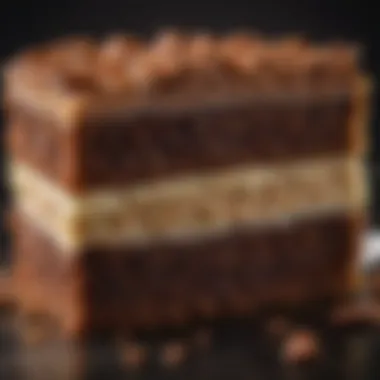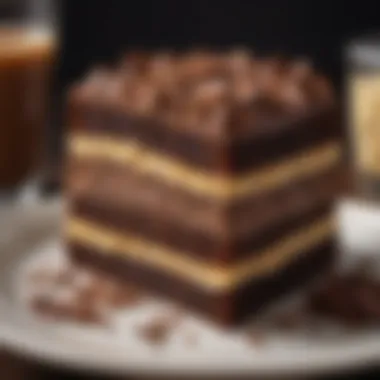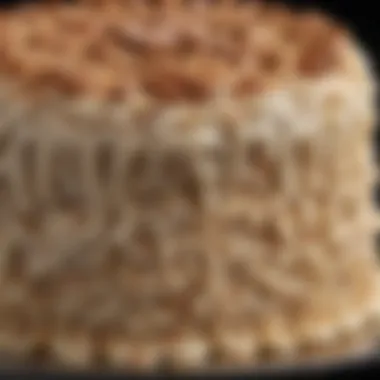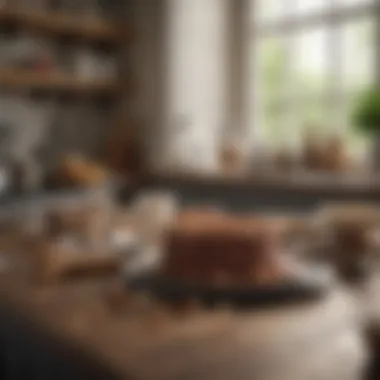Unveiling the Art of Baker's German Chocolate Cake


Intro
Baker's German Chocolate Cake stands as an iconic dessert in the pantheon of American baking. It is not merely a cake; it embodies a rich history, unique flavors, and a blend of textures that appeal to many taste buds. Its origins trace back to an Englishman named Samuel German, who developed a dark-baking chocolate for Baker's, a brand of the Baker's Chocolate Company, in 1852. This cake is notable for its three layers of rich chocolate cake, complemented by a luscious coconut-pecan frosting. The interplay of different flavors and ingredients ensures this cake's reputation endures.
This exploration will unfold the intricacies of preparing Baker's German Chocolate Cake. It will detail essential components such as the recipe, critical ingredients, and potential substitutes. Alongside this practical guidance, it will also delve into techniques and variations, ensuring that every reader, whether a novice or seasoned baker, can confidently create this delightful dessert.
In every bite of Baker's German Chocolate Cake, there lies a story. Understanding this tale enhances both the experience of baking and enjoying the cake.
Recipe Overview
- Recipe Name: Baker's German Chocolate Cake
- Cuisine Type: American
Ingredients
List of Ingredients with Measurements
- 1 cup (240 ml) of boiling water
- 4 oz (113 g) of Baker's semi-sweet chocolate
- 1 cup (200 g) of granulated sugar
- 1/2 cup (100 g) of packed brown sugar
- 1/2 cup (115 g) of unsalted butter, softened
- 2 large eggs
- 1 teaspoon of vanilla extract
- 1 3/4 cups (220 g) of all-purpose flour
- 1 1/2 teaspoons of baking powder
- 1 teaspoon of baking soda
- 1/2 teaspoon of salt
Substitutions for Common Ingredients
- Unsalted Butter: Can use margarine or coconut oil if necessary.
- Granulated Sugar: Substitute with coconut sugar or honey (reduce liquid in the recipe).
- All-Purpose Flour: Almond flour or gluten-free blends can work for gluten-free options.
Baker's German Chocolate Cake invites a variety of adaptations, ensuring that bakers can cater to different taste preferences and dietary needs.
Preamble to Baker's German Chocolate Cake
Baker's German Chocolate Cake is more than just a dessert; it symbolizes a rich culinary tradition. With layers of sumptuous chocolate cake paired with a unique coconut and pecan frosting, this cake stands out in the pantheon of baked delights. Understanding this cake's significance reveals not just the flavors involved but the stories and traditions behind it.
The cake's composition, particularly the contrasting textures of the moist cake and the crunchy frosting, creates an unforgettable eating experience. For those passionate about baking, mastering Baker's German Chocolate Cake is a rite of passage. This dessert encapsulates a blend of technical skills and creative expression, making each baking experience rewarding.
Origins of German Chocolate Cake
Despite its name, German Chocolate Cake has American origins. It all started in 1852 when a man named Samuel German created a dark-baking chocolate for the Baker's Chocolate Company. The cake gained fame many decades later in 1957 when a Texas newspaper published a recipe featuring this chocolate. This recipe drew attention to the unique coconut-pecan frosting which became a signature of the dessert.
The original name reflects the chocolate itself, not a connection to Germany. Over the years, the cake evolved through regional and personal variations, but the core chocolate texture and coconut flavor remained integral.
Defining Characteristics of the Cake
The defining characteristics of Baker's German Chocolate Cake lie in its layers and frosting. Typically, the cake consists of three layers of rich chocolate, offering moisture and depth. Each layer is enhanced by the unexpected blend of coconut and pecans in the frosting. This contributes a nutty taste and chewy texture to complement the smooth chocolate.
Moreover, the frosting is generally cooked, which allows the sugars to caramelize slightly, enhancing the flavor profile. This cake is not just a visual treat but also evokes a variety of flavors and textures that keep people coming back for more.
In summary, Baker's German Chocolate Cake is a testament to culinary innovation and cultural fusion. It combines premium ingredients and skilled preparation, resulting in a dessert that is both satisfying and memorable.
Key Ingredients
Key ingredients are critical to the success of Baker's German Chocolate Cake. Each component plays a distinct role in achieving the signature flavor and texture that makes this dessert remarkable. Understanding these ingredients helps in elevating the baking experience and ensuring a delicious outcome.
High-Quality Chocolate
Types of chocolate used
When it comes to types of chocolate, high-quality semi-sweet chocolate is often favored for German chocolate cake. This chocolate enhances the cake’s rich and deep flavors. Baker's German chocolate usually refers to a specific type of sweet baking chocolate, known for its balanced sweetness and cocoa intensity. Its unique formulation significantly impacts the overall taste of the cake, making it a preferred choice among many bakers.
The key characteristic of semi-sweet chocolate is its versatility. It complements both the sweetness of the cake and the richness of the frosting. Baker's German baking chocolate is essential in this recipe, providing a distinct sweetness that complements the other elements beautifully.
Impact on flavor
The impact on flavor when using quality chocolate is profound. It lends a deep and rich chocolatey taste that is essential for a successful cake. The chocolate's unique cocoa profile and sweetness add to the overall experience, making each bite flavorful and satisfying. Using inferior chocolate could lead to a lack of depth in flavor, which can result in a disappointingly bland cake.
Among bakers, high-quality chocolate is seen as a beneficial component. It provides authentic taste and enhances the sensory experience of eating the cake. This is important because flavor is one of the determining factors that contribute to the cake’s popularity.
Coconut and Pecan Frosting
Role of coconut
Coconut plays a significant role in the frosting of Baker's German Chocolate Cake. It introduces a chewy texture and a tropical flavor that contrasts well with the chocolate base. The addition of shredded coconut not only enhances the visual appeal of the cake but also contributes to its unique flavor profile.
The key characteristic of coconut is its ability to absorb and hold flavors. This makes it an excellent choice for the frosting, where it can work seamlessly with the sweetness of sugar and the richness of butter. This combination is appealing to many, as it adds an enjoyable texture to the cake.
Role of pecans
Pecans are essential for the frosting as well. They add a delightful crunch and a nutty flavor that balances the sweetness of the coconut and chocolate. The toasted pecans enhance the overall flavor profile of the cake, providing a sophisticated taste that distinguishes this dessert from others.
The unique feature of pecans is their rich, buttery flavor and chewy texture, both of which contribute positively to the overall cake experience. They also provide nutritional benefits, as nuts are a source of healthy fats and proteins.
Flavor contributions


The combination of coconut and pecans contributes significantly to the cake's distinctive flavor. They create a harmonious blend that enhances each bite. The rich chocolate base paired with sweet coconut and crunchy pecans offers a multi-dimensional tasting experience. This trio is what makes the frosting truly remarkable, setting Baker's German Chocolate Cake apart.
Batter Components
Flour, sugar, and eggs
The batter is the foundation of any cake, and Baker's German Chocolate Cake is no exception. The choice of flour, sugar, and eggs is critical for achieving the perfect texture and rise. All-purpose flour usually works best, providing the structure needed for the layers. The right proportions of sugar contribute to the cake's sweetness and help it retain moisture, while eggs act as a binding agent, giving the cake its rich body.
A unique feature of using these ingredients is how they interact during mixing and baking. Proper measurements and techniques are crucial; too much flour can make a dry cake, while too little can result in collapse. Therefore, precision in these components is key to success.
Importance of fresh ingredients
Fresh ingredients are vital in baking to ensure optimal flavor and texture. Fresh eggs, for example, contribute to the structural integrity of the cake. Using outdated or stale ingredients can lead to undesirable results.
Freshness plays a significant role as it can greatly affect not just taste but also the chemical interactions in baking. Each ingredient should be at its best for the recipe to yield a moist and flavorful German chocolate cake. Bakers often emphasize this point, as it can be the difference between a good cake and an exceptional one.
By focusing on these key ingredients, bakers can create a decadent German chocolate cake. Understanding their roles and choosing the right type can significantly elevate the baking process and the final product.
Preparation Techniques
Preparation techniques establish the foundation for a successful Baker's German Chocolate Cake. Proper methods help ensure that the cake rises beautifully, achieves the right texture, and boasts the delicious flavors that define this iconic dessert. Understanding each step can significantly influence the quality and appearance of the cake, making a thoughtful approach essential for both novice and seasoned bakers.
Mixing the Cake Batter
Measuring ingredients accurately
Measuring ingredients accurately is critical in baking. Precision can greatly influence the cake's structure and texture. Each ingredient serves a specific purpose; for example, too much flour can lead to a dense cake, while insufficient sugar may prevent it from being sweet enough. The key characteristic of measuring is its direct impact on the final product.
Using a kitchen scale often provides the best results, especially for main components like flour and sugar. While using measuring cups can work, it is sometimes less reliable. Accurate measurements contribute to achieving a uniform batter consistency. An advantage of meticulous measuring is that it allows for replicable results every time, which is beneficial for anyone looking to master this recipe.
Mixing methods
The mixing method chosen can affect the texture of the cake. For a moisture-rich cake like Baker's German Chocolate Cake, the creaming method is widely favored. This involves beating the sugar and fat together before adding eggs. This technique introduces air into the batter, which helps the cake rise during baking. Additionally, it ensures even distribution of ingredients throughout the mixture.
One advantage of the creaming method is that it creates a light and airy batter, promoting tenderness in the finished cake. However, it requires attention; overmixing can lead to a denser texture than desired. Using a mixer often simplifies this process, but hand mixing can offer more control over the consistency.
Baking the Cake
Baking times and temperatures
Baking times and temperatures play an essential role in the cake's final outcome. For Baker's German Chocolate Cake, a moderate oven temperature, typically around 350°F (175°C), allows the cake to bake evenly. Maintaining proper temperature is critical; too high, and the cake may rise too quickly, causing it to crack. Too low might result in undercooked batter.
The unique feature of adhering to recommended baking times ensures that the cake’s exterior does not burn while the interior stays properly cooked. A common suggestion is to start checking for doneness a few minutes before the suggested time. This careful monitoring is key, as baking too long can result in a dry cake.
Checking for doneness
Checking for doneness is a crucial skill for any baker. It involves assessing whether the cake has been baked sufficiently to be removed from the oven. The traditional method of inserting a toothpick in the center is widely known, where it should come out clean or with a few moist crumbs attached.
This practice ensures that the cake is neither underbaked nor overbaked. Relying on a timer alone may not account for variations in personal ovens, so this method adds a layer of confidence to the baking process. Yet, care is necessary; checking too frequently can disturb the baking environment. Thus, a balance between timing and testing is essential for optimal results.
Preparing the Frosting
Cooking the frosting mixture
Cooking the frosting mixture introduces a depth of flavor and an enjoyable texture. The process typically involves melting butter and combining it with other ingredients over low heat. This technique helps dissolve sugars and meld flavors effectively. A critical aspect of this is patience; slow cooking ensures even blending without burning.
While the cooking method adds complexity, it is rewarded with a rich, flavorful frosting that is characteristic of Baker's German Chocolate Cake. This unique feature enhances the taste profile, making the cake more delightful. However, it requires attention to avoid overheating or scorching, which would ruin the intended flavor.
Incorporating coconut and pecans
Incorporating coconut and pecans is a defining step in preparing the frosting. The addition of shredded coconut enriches the texture, while chopped pecans contribute a nutty crunch. Combining these elements leads to a distinctive frosting that is both creamy and textured. The key characteristic of this process is that it caters to depth in flavors, forming a delightful contrast against the sweet chocolate layers.
Using fresh coconut and quality pecans can amplify the final taste significantly. However, one should be mindful of balancing the quantity to avoid overwhelming the frosting. Proper incorporation ensures that each bite of the cake delivers a harmonious blend of flavors that truly uplifts the experience of enjoying Baker's German Chocolate Cake.
Assembling the Cake
Assembling the cake is crucial to creating Baker's German Chocolate Cake. This stage brings together all the elements of preparation, transforming the individual components into a cohesive and decadent dessert. Proper assembly ensures that the flavors meld harmoniously and enhances the visual appeal. This section addresses essential considerations in layering and frosting, highlighting the significance of each process.
Layering the Cake
Cooling the cake layers
Cooling the cake layers is an important aspect of assembly. Allowing the cake layers to cool completely before handling is crucial. This cooling period helps prevent the layers from breaking apart or becoming overly moist when frosting them. A key characteristic of this step is timing; it is beneficial to wait at least 30 minutes post-baking. This choice minimizes the chance of a messy assembly process, promoting better structure and flavor. The unique feature of cooling layers is that it allows the cake to set, making it easier to work with. However, a disadvantage is that impatience can lead to rushing the process, which can ultimately affect the final result.
Applying frosting between layers
Applying frosting between layers is essential for enhancing the cake's overall flavor. This practice not only adds richness but also helps bind the layers together. A key characteristic here is that the right amount of frosting can provide a delicate balance between sweetness and texture. This choice contributes to the moistness of the cake, ensuring each forkful is satisfying. The unique feature of applying frosting is that it creates visual appeal, making the inside of the cake look inviting. On the downside, too much frosting can overwhelm the cake's natural flavors, so moderation is key.


Frosting the Top and Sides
Techniques for spreading frosting
Techniques for spreading frosting play a significant role in the cake's final presentation. Using a spatula or a knife allows for even distribution, essential for aesthetics and taste. A prominent characteristic here is consistency; thicker frosting can create a smoother surface while a thinner one offers a more rustic appearance. This choice is beneficial as it allows for versatility in style, catering to different preferences. One unique feature of using varying techniques is the ability to create textures, such as swirls or smooth finishes. However, if one is not careful, overworking the frosting can lead to a less desirable outcome, as it may incorporate air pockets.
Creating a decorative finish
Creating a decorative finish elevates Baker's German Chocolate Cake from delicious to visually stunning. This final touch can be as simple as adding toasted pecans or shredded coconut on top. A key characteristic of this step is its potential to reflect personal style; decorations can be tailored to suit any occasion. This choice not only appeals to guests visually but also invites curiosity. The unique feature of creating a decorative finish adds a personal touch and sometimes highlights the main flavors. However, an overly ornate design can distract from the cake itself, so it is essential to find a balance.
Presentation and Serving
Presentation and serving are critical aspects of any dessert, especially a richly layered one like Baker's German Chocolate Cake. The way a cake is presented impacts not only the visual appeal but also enhances the entire tasting experience. A well-presented cake invites anticipation and excitement, contributing to the enjoyment of the dessert. From choosing the right dishware to pairing it with complementary items, every detail plays a role.
Choosing the Right Dishware
Selecting the appropriate dishware is essential for serving Baker's German Chocolate Cake. A cake stand elevates the dessert, literally and figuratively, showcasing the layers and frosting. It also allows for ease in serving and adds sophistication to any gathering. Opting for clear glass or simple ceramic can help highlight the cake’s rich colors without overpowering it.
When choosing a plate or serving platter, consider the size of the cake. It should fit comfortably without appearing overcrowded. Additionally, the colors and design of the dishware should align with the cake's appearance. A white plate offers a striking contrast against the dark chocolate and frosted elements, emphasizing the cake’s beauty.
Pairing Suggestions
Beverages that complement the cake
When it comes to beverages that enhance the experience of Baker's German Chocolate Cake, several choices stand out. Coffee is perhaps the most traditional pairing. Its bold flavors contrast nicely with the sweetness of the frosting. A rich, dark roast can elevate the chocolate notes in the cake.
Tea is another popular option. A robust black tea, such as Assam, complements the cake without overwhelming it. The tannins in the tea can cut through the richness of the frosting, making each bite more enjoyable.
Dessert wines, like tawny port, can also be a suitable match. Their sweetness and depth can mirror the cake’s flavor profile, adding to the overall indulgence. However, it’s important to balance sweetness; a dryer wine might not work well with the cake’s sweet elements.
Accompanying desserts
Accompanying desserts can create a delightful multi-course experience. Small bites like chocolate truffles or a fruit tart provide a contrasting flavor that nicely counterbalances the cake's richness. A citrus-based dessert, such as a lemon tart, serves to cleanse the palate, enhancing the enjoyment of Baker's German Chocolate Cake.
Another option is a scoop of vanilla ice cream. The creaminess of the ice cream offers a cooling balance to the cake's sweetness and creaminess. This combination works well, especially when served warm. However, it's essential to consider portion sizes to ensure that neither the cake nor the accompanying dessert overshadows the other.
Mixing different desserts can create a symphony of flavors, enriching the overall dining experience.
Variations of the Classic Recipe
Exploring variations of Baker's German Chocolate Cake is important. It allows bakers to customize flavors and adapt to different dietary preferences. Whether for health reasons or taste, variations can cater to a wider audience.
Gluten-Free Alternatives
Substituting flours
When considering gluten-free alternatives, substituting flours is essential. Common flour substitutes include almond flour, coconut flour, and gluten-free all-purpose blends. The key characteristic of these flours is their ability to provide structure without gluten. Each type of flour brings something unique to the cake. For instance, almond flour lends a nutty flavor while adding moisture. Gluten-free all-purpose mixes are formulated to mimic all-purpose flour closely. This adaptability makes them popular choices for those avoiding gluten. However, substitution must be done carefully to maintain the right texture.
Maintaining texture and moisture
Maintaining texture and moisture is crucial when using gluten-free flours. Gluten-free cakes often have a different crumb, which can lead to dryness. It’s important to add liquid ingredients like yogurt or applesauce. This enhances moisture and ensures a tender crumb. The unique feature of these adjustments is they keep the cake's flavor vibrant while avoiding dryness. If one doesn’t ensure adequate moisture, the cake can turn dense and unenjoyable. This aspect is vital for successfully baking gluten-free versions of the cake.
Vegan Adjustments
Replacing eggs and dairy
Vegan adjustments are key for creating a dairy-free and egg-free version of Baker's German Chocolate Cake. Common replacements include flaxseed meal for eggs and almond milk or coconut milk for dairy products. The main characteristic of these substitutes is that they replicate the binding and richness of traditional ingredients. Flaxseed meal, when mixed with water, becomes gelatinous and serves as an egg substitute. This choice is beneficial for many who choose vegan diets. However, it may slightly alter the texture compared to using real eggs. Careful measurement will ensure good results without sacrificing flavor.
Achieving similar flavors
Achieving similar flavors in vegan recipes involves using thoughtful ingredient substitutions. For instance, incorporating cocoa powder or cacao nibs maintains the chocolatey essence. Additionally, using vanilla extract enhances sweetness without actual sugar boosts. The key feature here is ensuring that flavor intensity is retained, even without animal products. This is beneficial, as many enjoy the cake's rich taste. Yet, achieving the balance of flavors can be challenging. It requires understanding how each ingredient contributes to the final profile of the cake.
Exploring variations often leads to delightful discoveries, enhancing the art of cake baking.
Baker's German Chocolate Cake can be a wonderful dessert for everyone, whether they have dietary restrictions or not. Each variation offers a unique take while preserving the spirit of the classic recipe.
Storing and Preserving the Cake
Storing and preserving Baker's German Chocolate Cake correctly is essential for maintaining its flavor and texture. Attention to these details ensures that this beloved dessert remains moist and delicious, whether served immediately or saved for later.
Best Practices for Storage
Refrigeration versus room temperature
Deciding whether to refrigerate or store the cake at room temperature can significantly affect its taste and texture. Generally, refrigerating the cake is beneficial if it contains frosting made from cream or if the cake is to be kept for a longer duration.
Refrigeration can help to slow down the growth of bacteria, making it a safer choice for those who want to preserve their cake. However, refrigeration can lead to a slight drying effect, which may impact the overall enjoyment.


On the other hand, storing the cake at room temperature is an ideal choice for short-term preservation. It retains moisture and keeps the texture soft. However, this also requires a careful environment, away from heat sources or direct sunlight. The best practice is to monitor the duration the cake is kept out, ensuring it does not exceed a couple of days to maintain optimal freshness.
Key Point: Choose refrigeration for longer storage, while room temperature can be suitable for short-term enjoyment.
Covering methods to prevent drying
Using proper covering methods is crucial in preventing the cake from drying out. A common mistake is leaving the cake uncovered, which leads to the loss of moisture. Wrapping the cake with plastic wrap or aluminum foil effectively traps moisture inside while keeping out air.
Another popular method is using an airtight container. This option offers the advantage of preventing the cake from absorbing any unwanted odors from the refrigerator. It is also easy to access whenever you crave a piece.
However, it is vital to ensure that any covering is done gently to avoid disturbing the frosting or cake layers. By choosing appropriate methods, the cake can remain fresh and maintain its integrity for several days after baking.
Freezing the Cake
Freezing is an excellent option for long-term storage of Baker's German Chocolate Cake. This method preserves the cake without sacrificing its flavor. Freezing layers individually is advisable, particularly for those who want to the take out only a portion at a time.
Techniques for freezing layers
To freeze layers properly, allow them to cool completely. Wrapping each layer in plastic wrap before placing it in a freezer-safe bag will prevent freezer burn. This approach helps keep the intense chocolate flavor intact while avoiding dryness. Freezing allows you to preserve the cake for up to three months without losing its appeal.
Additionally, labeling the bags with dates ensures that you are aware of how long the cake has been in storage, making it easier to manage what is available for use.
Defrosting procedures
Defrosting is equally important to maintain the cake's texture after freezing. The best method involves moving the frozen cake to the refrigerator to thaw slowly. This technique allows the cake to retain moisture as it comes to a temperature. It usually takes several hours or overnight for the cake to thaw adequately.
Alternatively, if you are pressed for time, you can leave the cake at room temperature for about an hour. However, direct exposure to heat or sunlight should be avoided.
In summary, a good approach to storing and preserving Baker's German Chocolate Cake involves understanding the balance between refrigeration, room temperature, and proper wrapping techniques. Moreover, freezing and defrosting methods are equally important to ensuring the cake maintains its rich flavor and satisfying texture. Following these guidelines will help cake lovers enjoy their treat at its best.
Nutritional Considerations
Understanding the nutritional aspects of Baker's German Chocolate Cake is essential for both bakers and consumers. This cake, well-loved for its taste, also brings certain nutritional elements to the table. Analyzing its ingredients can yield insights into how it fits into balanced diets and how modifications can enhance its health benefits.
Caloric Content and Ingredients
Baker's German Chocolate Cake is known for its rich flavor profile, but it also comes with a considerable caloric content. The primary components, such as sugar, butter, and chocolate, play a significant role in the overall calorie count. On average, a slice can contain around 300 to 500 calories, varying based on portion size and recipe specifics.
The main ingredients include:
- Sugar: Contributes sweetness and density.
- Butter: Adds richness and flavor.
- Chocolate: Provides depth of flavor and texture.
- Coconut and pecans: Offer additional fat, fiber, and unique taste.
While these ingredients create an indulgent treat, they can also lead to dietary concerns, particularly for those monitoring their caloric intake.
Nutritional Alternatives
As more people seek healthier options, alternatives to traditional ingredients can be explored without compromising flavor.
Reducing Sugar
Reducing sugar in Baker's German Chocolate Cake can significantly affect overall health without sacrificing satisfaction. Cutting sugar can lessen the calorie count, which helps in maintaining weight or improving general health. One popular method is substituting with natural sweeteners like honey or maple syrup. These alternatives can provide sweetness with added benefits like nutrients and lower glycemic indices.
The key characteristic of reducing sugar is that it results in a less sweet cake, which can be a beneficial choice for those reducing sugar for health reasons. However, it’s important to note that this can affect texture, making the cake denser or altering moistness.
Finding Healthy Fats
Finding healthy fats is another essential consideration when making a nutritious Baker’s German Chocolate Cake. Instead of traditional butter, options like coconut oil or avocado can be used. These fats not only lower saturated fat intake but also introduce beneficial fatty acids.
The key characteristic of using healthier fats is that they can improve heart health while maintaining the cake's overall richness. While replacing butter with healthier alternatives can have its downsides—such as a shift in flavor or texture—the nutritional payoff often outweighs these challenges, making it a worthwhile adjustment for conscientious bakers and cake lovers alike.
Closure
In this article, we have examined the multifaceted world of Baker's German Chocolate Cake, a dessert that tangles together its rich history with a unique medley of flavors. The conclusion serves as a culmination of essential points covered throughout. Understanding the significance behind each component—from the cake base to the iconic coconut-pecan frosting—underscores the importance of quality ingredients and skilled techniques in the baking process.
The article also highlights various practices that ensure the cake’s longevity in both flavor and texture. From storage methods to variations adapted for specific dietary needs, these considerations amplify the overall experience and make the cake accessible to a broader audience. Experimentation is welcomed and encouraged, pushing the boundaries of traditional recipes while maintaining the essence that makes this cake a beloved classic.
Recap of Essential Steps
To effectively master Baker's German Chocolate Cake, the following steps are crucial:
- Understanding Ingredients: Each key component plays a role in the final flavor profile and texture. Choosing high-quality chocolate, fresh coconut, and pecans is fundamental.
- Preparation Techniques: Accurate measuring and mixing methods influence the cake’s density and quality. Following proper baking times ensures doneness without overcooking.
- Layering and Frosting: Cooling layers adequately before assembly is necessary for stability. Applying frosting between layers and around the edges requires care for visual appeal and taste enhancement.
- Storage Practices: Ideal storage conditions prolong the cake's freshness. Knowing when to refrigerate or freeze is vital for maintaining its delightful texture.
These steps form the backbone of a successful baking endeavor, aligning with both tradition and modern adaptations.
Encouragement for Experimentation
Baking, particularly with desserts like Baker's German Chocolate Cake, is an art form that invites personal touches. While mastering the classic recipe is worthwhile, there is joy in making it your own. Consider the following:
- Incorporate New Flavors: Add a layer of caramel or a hint of espresso to enhance depth.
- Explore Ingredient Substitutions: Experiment with gluten-free flour blends or dairy-free options for those with dietary restrictions.
- Customize Frosting: While coconut-pecan is traditional, other nut combinations, or flavored frostings can provide a unique twist.
Engaging with the recipe allows for creativity while respecting its legacy. Whether you’re a seasoned baker or a novice, the process of experimentation fosters growth in your culinary skills. Embrace the opportunity to innovate and make the cake a reflection of your taste and personality.
Remember: Every successful culinary journey stems from knowledge, practice, and the willingness to try something new. - Your exploration contributes to the cake’s evolving narrative.















